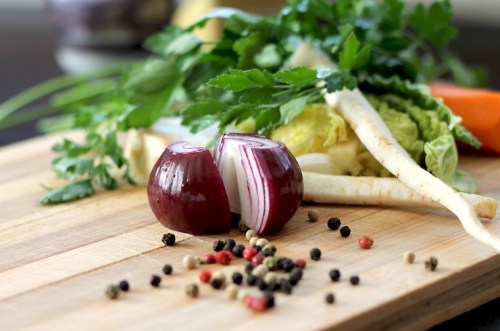A bout of bloating can be a total confidence killer—especially if it’s coupled with IBS, which affects one in five Americans. That’s pretty pervasive for something we pretty much never talk about. (Squatty Potty habits aside.) “Most people are suffering in silence because it isn’t really something you discuss at a cocktail party,” explains Kate Scarlata, RDN. As a remedy, many try cutting out dairy. Others try gluten. Sometimes it works, and sometimes it doesn’t, she says.
What gives? It turns out, often the cause of gastric distress lies in short-chain carbohydrates, also called high FODMAP foods. FODMAP stands for Fermentable Oligosaccharides, Disaccharides, Monosaccharides, and Polyols. (See why it’s an acronym?)
If you’ve never heard about it, you’re not alone—FODMAPs only recently landed on the radar of healthy Americans. But if you suffer from regular bloating, IBS, or other can’t-get-to-the-bottom-of-it health issue, a low FODMAP diet could totally change your life.
Scroll down for everything you need to know about the FODMAP Diet.

WTF are FODMAPs?
Even though this whole FODMAP concept is just starting to buzz here in America, it’s been super influential in Australia since 2005, when a research group at Melbourne’s Monash University figured out that food with short-chain carbs are poorly absorbed, which leads to (drumroll) bloating. “They pull water inside the small intestine and are fermented by gut bacteria, the combination of which creates this bloating sensation,” says Scarlata, who is a FODMAPs expert. “People who have IBS have very sensitive intestines and the stretching really contributes to a lot of pain.”
The tricky thing about identifying high FODMAP foods (that would be the short-chain carbs that are hard to digest) is that they are found in a lot of different food groups—even fruits and vegetables. Broccoli, onion, cashew nuts, beets, mushrooms, and watermelon all have short-chain carbs. The researchers attempted to make it easier by creating six subgroups of classification: fructose (simple sugar often found in fruit), lactose (exactly what you think it is), fructans (found in many gluten-based grains), galactans (found in legumes), and polyols (a sugar alcohol).
Some examples of high FODMAP foods:
- Apples
- Garlic
- Chamomile
- Beans
- Asparagus
- Onion

How to follow a low FODMAP diet
Scarlata says not everyone has a problem with all the different FODMAP groups, which is why it’s important to work with a nutritionist to figure out what exactly your specific trigger foods are. (There are also some at-home tests that can help with this process, although it’s still best to work with an expert to figure things out.)
“It’s a three-phase process,” Scarlata says. “The first phase is the elimination phase where patients remove all high FODMAP foods from their diet.” After that, each subgroup is slowly introduced back into the diet, one at a time. That way, you know if it’s the lactose group that’s a problem, the fructans group, or one of the others.
And yes, this is definitely a better route to go than playing it safe and avoiding foods in any the FODMAP subgroups completely: “Since FODMAPs are found in innately healthy foods, you don’t want to overly restrict the diet if you don’t have to,” Scarlata says. Avoiding all FODMAP foods forever is definitely not the goal.
The third phase is eating what you want while avoiding the high FODMAP foods that fall within the groups that were a trigger during phase two.
Grueling? Maybe. But Scarlata says it’s worth it. “Ninety-nine percent of the time, my patients see [a change] within a few days,” she says. The result really is that immediate, she says, and if you stick within the guidelines, long lasting.

Living the low FODMAP life doesn’t have to be hard
As someone whose anxiety and nerves definitely manifests itself in my gut, I decided to give the low-FODMAP diet a try to see if I noticed a difference. Admittedly, I did exactly what I was told not to do and cut out all high FODMAP foods without going through the elimination food diet first—but I can tell you that I noticed a difference immediately. I no longer felt bloated in the late afternoons, as I sometimes do after lunch, and my gut has been a lot calmer overall.
Since identifying high FODMAP foods is so tricky, make sure to bookmark a site (or this pretty graphic) that details all of the low and high FODMAP foods. (I’ve been relying on LowFODMAP Central, which was created by Nestle—yes, that Nestle, but it’s really straightforward and informative.) It will make life way easier when you’re strolling the aisles at Whole Foods or opening up a menu at your favorite restaurant. Bonus points if you’re able to memorize the dos and don’ts.
Once you know which high FODMAP food categories are triggers for you, you’ll know what to avoid and what your go-to replacement foods are. Hopefully that means you can say bye to bloating for good. You might miss watermelon or cashews, but you will definitely not miss that feeling.
Originally published July 26, 2016; updated May 31, 2019.
Ready to become a healthy gut expert? Here are seven things you need to know. Plus, fhere’s how to identify which gut type you actually have.
Sign Up for Our Daily Newsletter
Get all the latest in wellness, trends, food, fitness, beauty, and more delivered right to your inbox.
Got it, you've been added to our email list.











